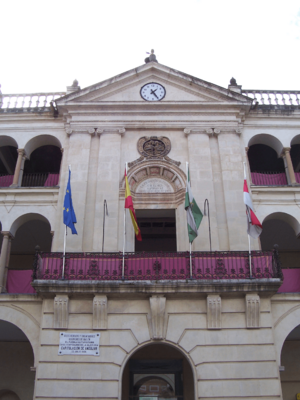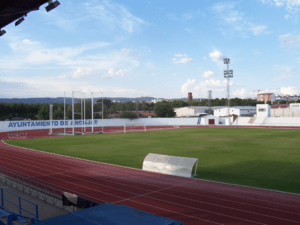Andújar facts for kids
Quick facts for kids
Andújar
|
|||
|---|---|---|---|

City Hall of Andújar
|
|||
|
|||
| Country | |||
| Autonomous community | |||
| Province | Jaén | ||
| Comarca | Campiña de Jaén | ||
| Government | |||
| • Body | Ayuntamiento de Andújar | ||
| Area | |||
| • Total | 964,9 km2 (3,725 sq mi) | ||
| Elevation | 212 m (696 ft) | ||
| Population
(2018)
|
|||
| • Total | 37,113 | ||
| • Density | 39,36/km2 (10,190/sq mi) | ||
| Demonyms | Andujareño/a, iliturgitano/a | ||
| Time zone | UTC+1 (CET) | ||
| • Summer (DST) | CEST | ||
| Postal code |
23740
|
||
| Official language(s) | Spanish | ||
Andújar (Spanish pronunciation: [anˈduxaɾ]) is a city in Spain, located in the province of Jaén, in the region of Andalusia. About 37,000 people live here. The city is split by the Guadalquivir River. North of the river is the Sierra de Andújar Natural Park, a beautiful area with nature. To the south, you'll find farms and open land. Andújar was once famous for its special clay jars. These jars, called alcarrazas or botijos, could keep water cool even on the hottest days. They were made from a unique white clay found nearby.
Contents
History of Andújar
Ancient Times
People have lived in the Andújar area for a very long time. Tools from the Stone Age have been found here. During the Neolithic Age, more people settled down. They started farming the rich land and mining in the Sierra Morena mountains.
The first known people to live here were the Oretani. They were an Iberian tribe who built a town called Isturgi. Today, the village of Los Villares de Andújar stands where Isturgi once was.
Later, during the Roman Empire, Isturgi became an important Roman town. It was known for making special pottery and was located along the Guadalquivir River. After the Roman Empire ended, the town was called Sturgi by the Visigothic people. But when the Moors arrived in the 8th century, many people moved to where Andújar is now.
Medieval Era
In 711 AD, the region became part of Al-Andalus, a Muslim kingdom. The town of Andújar was first called Anduyar around 853. The Almohads built strong walls around the city in the 12th century to protect it.
In 1225, the Christian king Ferdinand III of Castile gained control of some castles in the area, including Andújar. This was part of the Christian reconquest of Spain. Andújar became a meeting point for Christian armies fighting in the south. By 1226, most Muslim residents had left the town.
New Christian settlers arrived in Andújar in 1227 or 1228. In 1467, King Henry IV of Castile officially gave Andújar the title of "City."
Modern Times
During the Napoleonic Wars in 1808, French troops took over Andújar. A French general, Pierre Dupont de l'Étang, made the city his headquarters. He sent troops from Andújar to Bailén, where they lost an important battle. After this defeat, the peace agreement was signed in Andújar.
In 1835, a group called the Junta de Soberanía Central de Andalucía was formed in Andújar. This group was a pioneer for the idea of self-rule in the region of Andalusia. In 1873, Andújar was declared a federal canton, meaning it had more local power.
During the Spanish Civil War, a group of soldiers took shelter in the Sanctuary of the Virgen de la Cabeza. They were surrounded by opposing forces for about a year.
Climate in Andújar
Andújar has a Mediterranean climate. This means it has very hot and dry summers. Winters are mild and wet. The city is in the eastern part of the Guadalquivir valley. Its winters are similar to Córdoba but colder than Seville because it's further inland. Summers are extremely hot. Average high temperatures often go above 37.5°C (99.5°F). Andújar, along with nearby towns, often has the highest average summer temperatures in Europe.
| Climate data for Andújar | |||||||||||||
|---|---|---|---|---|---|---|---|---|---|---|---|---|---|
| Month | Jan | Feb | Mar | Apr | May | Jun | Jul | Aug | Sep | Oct | Nov | Dec | Year |
| Mean daily maximum °C (°F) | 15.8 (60.4) |
18.0 (64.4) |
22.0 (71.6) |
23.8 (74.8) |
28.2 (82.8) |
34.0 (93.2) |
37.8 (100.0) |
37.2 (99.0) |
32.4 (90.3) |
26.0 (78.8) |
19.9 (67.8) |
16.4 (61.5) |
26.0 (78.7) |
| Daily mean °C (°F) | 9.5 (49.1) |
11.2 (52.2) |
14.4 (57.9) |
16.2 (61.2) |
20.0 (68.0) |
25.0 (77.0) |
28.0 (82.4) |
27.6 (81.7) |
23.9 (75.0) |
18.7 (65.7) |
13.5 (56.3) |
10.5 (50.9) |
18.2 (64.8) |
| Mean daily minimum °C (°F) | 3.1 (37.6) |
4.4 (39.9) |
6.7 (44.1) |
8.5 (47.3) |
11.7 (53.1) |
15.9 (60.6) |
18.2 (64.8) |
18.0 (64.4) |
15.3 (59.5) |
11.3 (52.3) |
7.0 (44.6) |
4.6 (40.3) |
10.4 (50.7) |
| Average precipitation mm (inches) | 57.4 (2.26) |
50.9 (2.00) |
41.3 (1.63) |
55.2 (2.17) |
38.8 (1.53) |
12.8 (0.50) |
3.3 (0.13) |
5.6 (0.22) |
26.2 (1.03) |
63.2 (2.49) |
75.1 (2.96) |
91.8 (3.61) |
521.6 (20.53) |
| Source: World Meteorological Organization | |||||||||||||
Local Holidays and Traditions
Andújar has two Christian patron saints: the Virgen de la Cabeza and St. Euphrasius of Illiturgis.
The most famous local event is the Pilgrimage of the Virgen de la Cabeza. It happens on the last Sunday of April. During this pilgrimage, people visit the sanctuary on the Cabezo hill. A local story says that on August 12, 1227, a shepherd saw strange lights and heard a bell ringing on the hill. He climbed up and found the image of the Virgen de la Cabeza.
A local fair, called a feria, is also held in September. It used to be mainly for selling cattle, but that has changed. However, the fair still has booths and stands, and it's a fun event for the community.
Sports in Andújar
Andújar has an 80-year-old football (soccer) team called Club Deportivo Iliturgi. They play in the third division of the national soccer league. For futsal (indoor soccer), the local team is Andújar Fútbol Sala. They play in the First National Division A.
In September 2008, Miguel Ángel Martínez Tajuelo, a Paralympic swimmer from Andújar, competed in the Paralympic Games in Beijing. He was the first person from the city to do so. He achieved great results, placing 5th in the 100-meter race, 6th in the 50-meter race, and 5th in the 50-meter backstroke.
Neighborhoods
- Barrio Montañés
- Los Belenes
- Polígono Puerta de Madrid (a working-class area with sectors like Huelva, Almería, Sevilla, and Granada)
- Barrio de la Paz (also known as Barrio de la UVA)
- Barrio San Bartolomé
- Emperadores
- La Pastora
- Las Vistillas
- Cuadro de la Virgen
Twin Towns and Sister Cities
Andújar is connected with:
 Favara, Italy
Favara, Italy
See also
 In Spanish: Andújar para niños
In Spanish: Andújar para niños







